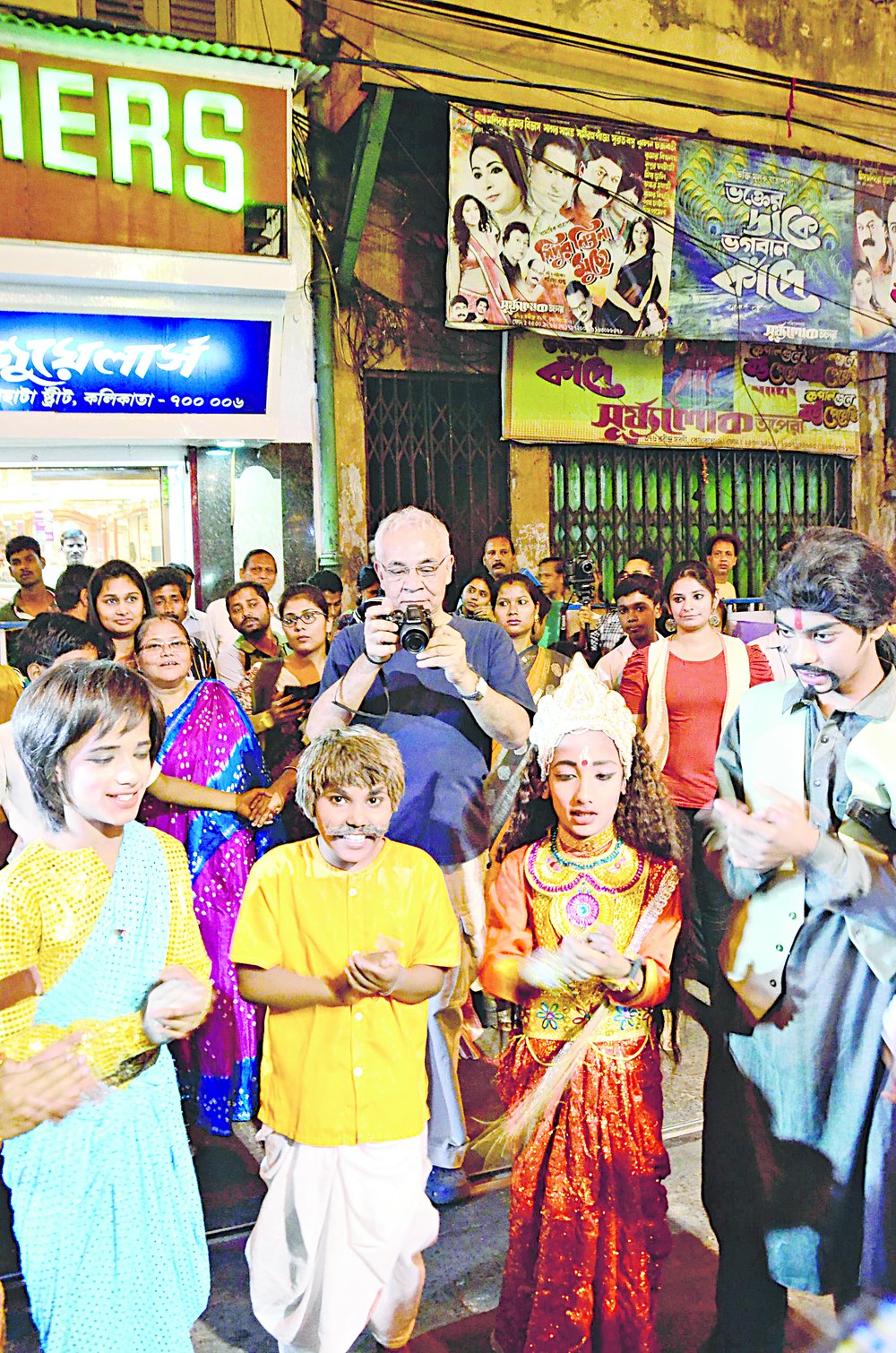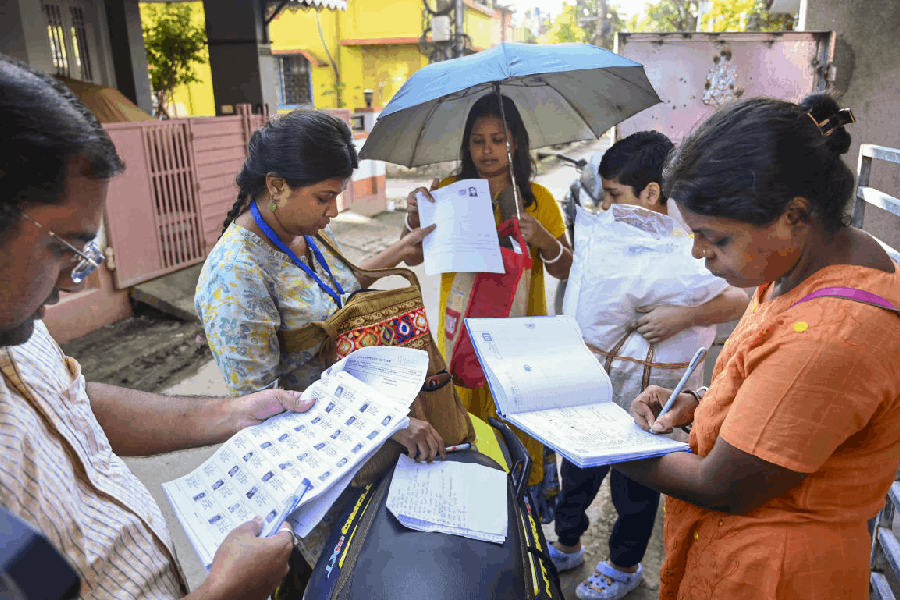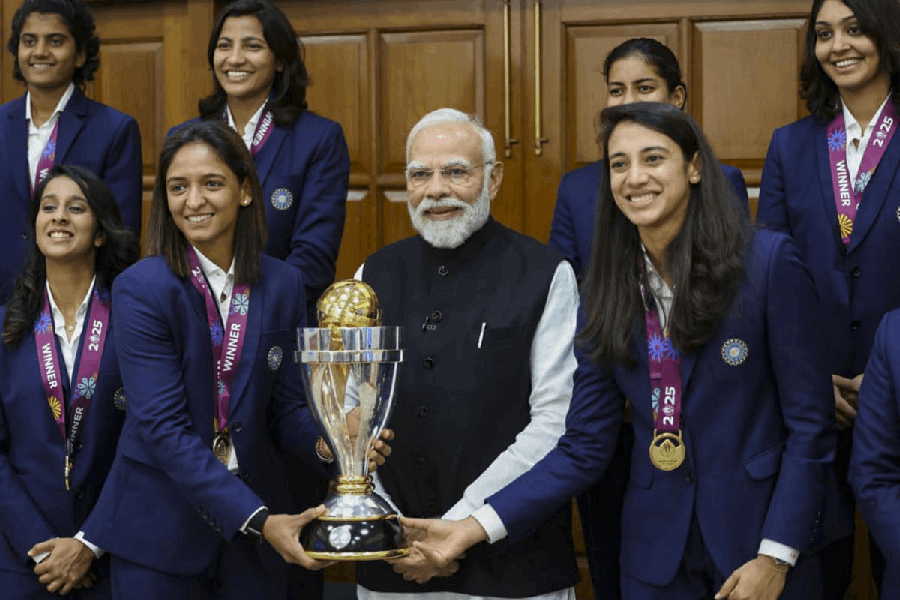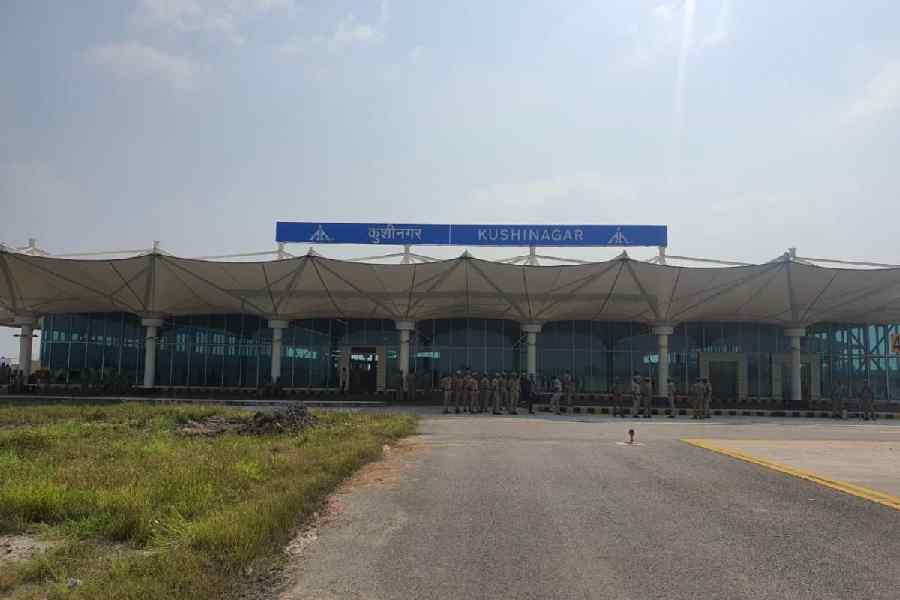
Actor Dhritiman Chaterji captures the action on camera as students of The Oriental Seminary walk the streets of Chitpur for Jatra Unplugged!, presented by Mad About Drama on Saturday. “Chitpur has been the seat of jatra. To survive, this art too has had to go through many changes. It has been contemporised, but not all the changes have been for the better. It is great that the younger generation is being made aware of jatra,” he said. Picture by B. Halder
Does The Oriental Seminary, where Rabindranath Tagore studied briefly, really lie in Chitpur? Well, not technically. Its postal address may say 'Chitpur Road' but in reality, the red heritage building stands on the road leading to Chitpur.
Such urban trivia and tales were one of the many attractions that unfolded at Chitpur Local - Celebrating a Heritage, a festival presented in association with The Telegraph on Friday and Saturday.
Born out of an art project in November 2013 and now funded by the India Foundation for the Arts,the festival transformed Chitpur Road, Garanhata Street and many other places in the area into a hub of art, performances, games, storytelling and more. If Day 1 saw an adda on the history of Chitpur, Day 2 started with a photowalk. There were jatra, songs, a pop-up museum and film screenings too.
The adda, initiated by The Centre for Studies in Social Sciences and titled 'Time travelling through Chitpur', was held at the 186-year-old The Oriental Seminary. Sitting in the audience, their eyes fixed on a white screen, a bunch of students of the school eagerly took in the Chitpur stories.
On the dais was an exhibit - a collage of pictures on the many faces and facets of Chitpur - done up in the shape of a book. Researcher Indira Biswas of the Centre, and Rajat Kanti Sur, a doctoral fellow of the department of South and Southeast Asian studies, Calcutta University, helped the audience go back in time, learning about photographs that adorned a babu's baithakkhana, the Battala printing culture and the first generation of women radio singers.
But first, the actual sprawl of Chitpur was explained with the help of a map. The school lies in Upper Chitpur, said Sur, while Lalbazar, Nakhoda Masjid and Marble Palace are part of Lower Chitpur. Again, Nimtala ghat to Galiff Street are part of Upper Chitpur. This road was always busy and noisy in the absence of Central Avenue, which took 20 years (from 1920) to get ready.
According to records the road has been around for centuries, with Siraj-ud-Daulah and his troops passing through it, and even before that. It has found a mention in many literary and historical texts, like Vivekananda's brother Mahendra Nath Dutta's 1929 book on Calcutta and its customs, Kolikatar Puratan Kahini O Protha.
'The term 'Chitpur Road' was coined only in 1792, following a map by A. Upjohn,' said Sur. Always a hub of popular culture, Chitpur was known for processions taken out by a set of people often dressed as gods and goddesses and mythological characters. These were Kansaripara shongs, whose songs were often laced with sarcasm.
'They did not even spare Raja Rammohun Roy,' Sur said. Their preferred route was Vivekananda Road-Beadon Street-Nimtala- Garanhata Street and finally to the house of the millionaire, Ramdulal Sarkar.
The audience got to hear snatches of one such song, its lyrics a curious mix of English and Bengali. Processions of shongs are not extinct, despite a British ban on them in 1876, after their songs targeted an English top cop. Kalighat still has a few shongs, as also Jelepara.
Chitpur's famed printing presses and studios dating back to pre-Independence days were also discussed. Biswas shared a few Battala pictures from the archives of the Centre. Popular pictures from mythology, which were a favourite with the babus and bhadroloks, often came from Chitpur studios.
'An interesting trend was fusing Indian characters in a foreign backdrop,' said Biswas, showing a series of such photographs. In one, Sita's agnipariksha takes place before a grand manor house with a chimney. In another, Durga's homecoming is portrayed in European countryside.
'Such picture collages and superimpositions marked a popular trend in the 19th century and they were started by Chorbagan Art Studio (in Chitpur),' she added.
Another interesting aspect of the adda was the focus on the first generation of women radio singers, some of whom went on to have gramophone records of their own. Rehearsals and recordings often took place in Chitpur.
Black-and-white photographs of pretty young girls like Indubala, Ranibala or Pushparani Bhattacharya, many of them dying too young to enjoy their popularity or take up music as a career, captivated the audience as they listened to stories of how radio allowed women from 'decent families' to come out and sing for the masses, transforming their own lives along the way.
When a group of 45 shutterbugs gathered in front of the Lalbazar police headquarters at 7am on Saturday, naturally they drew stares from policemen and pedestrians alike. But they weren’t tourists, they were Calcuttans enthusiastic enough to wake up early on a weekend, and curious enough to know about an overcrowded yet integral part of the city. Organised by Calcutta Walks for Chitpur Local: Celebrating a Heritage, a two-day festival presented in association with The Telegraph, this was a photowalk that touched upon various locations across Chitpur. Starting from White Town: Sahib’s Calcutta (as the area around Lalbazar used to be known) the walk took them to Black Town: Babu’s Calcutta (north of MG Road), past Grey Areas: Traders’ Calcutta, with photo stops in Old China Town, Tiretta Bazaar, Sea Ip Church, Parsi fire temple, Mechhua Bazaar and Nakhoda Masjid, and ending at the Chitpur Local pop-up museum opposite The Oriental Seminary, Rabindranath Tagore’s alma mater.

If there’s one building in the area that’s synonymous with Chitpur, it’s Nakhoda Masjid. The photowalkers were led up an old, dark staircase in a building opposite the mosque. The house belongs to Sohail Bhai, owner of the Royal Indian Hotel and descendant of the royal cooks serving Wajid Ali Shah. On its terrace, the group went click-crazy, for rising from behind a red facade were the famous green minarets of Nakhoda Masjid. The mosque was built by Gujarati Muslim traders, who arrived in the area on ships, and was so named as nakhoda means mariner. Next to the mosque is Salim Manzil, where the great classical singer and courtesan Gauhar Jaan lived.

Past Chattawala Gali stands Sea Ip Church, said to be the most accessible of the six Chinese temples in the area. The temple is dedicated to Kwan Yin, the Chinese goddess of war, mercy and love. Decorating the walls is an array of
Chinese weapons.

One of the stops was Hap Hing Co., a quaint little Chinese shop near Tiretta Bazaar, run by the smiling Stella Chen, whose grandparents settled in Calcutta in 1930 and started this shop. She treated her guests to dried sugar plums. The shop also sells mandarin peels, medicines, ointments, noodles and more.

The Harmonic lounge on the third floor of the building that houses the city police’s traffic wing at Lalbazar gets its name from the Harmonic Tavern, which was located in this building in the early 18th century.

The walk was halted for a bite of mawa laddoos from M.E. Karodia Sweets at the Canning Street-Rabindra Sarani crossing. While some were happy with one, others got many packed for home.



Text by Trina Chaudhuri
Pictures by Arnab Mondal
Did you attend Chitpur Local? Tell ttmetro@abpmail.com











